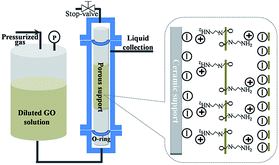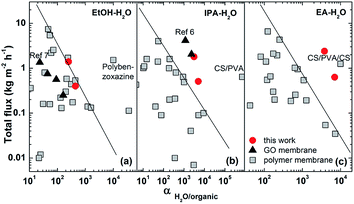Efficient dehydration of the organic solvents through graphene oxide (GO)/ceramic composite membranes†
Guihua Liab,
Lei Shic,
Gaofeng Zeng*a,
Yanfeng Zhang*a and
Yuhan Suna
aCAS Key Laboratory of Low-carbon Conversion Science and Engineering, Shanghai Advanced Research Institute, Chinese Academy of Sciences, Shanghai 201210, China. E-mail: zenggf@sari.ac.cn; zhangyf@sari.ac.cn; Fax: +86 21 20350997; Tel: +86 21 20350997
bCollege of Sciences, Shanghai University, Shanghai 200444, China
cShanghai Institute of Microsystem and Information Technology, Chinese Academy of Sciences, Shanghai 200050, China
First published on 10th October 2014
Abstract
Porous Al2O3 tube supported GO composite membranes with submicron thickness and improved mechanical strength were fabricated via a filter-pressing deposition method. High separation performance (flux, selectivity and stability) was achieved in the pervaporation of ethanol, n-propanol, iso-propanol, ethyl acetate and butanol isomers aqueous mixture.
Dehydration of organic solvents is an important industrial separation process. Traditional thermal processes have always been energy intensive and cannot separate azeotropics with low energy penalty. Membrane separation has been widely studied as a viable alternative to these traditional methods because it offers advantages of high efficiency, low cost and energy saving. Pervaporation is one such type of membrane process with wide application in azeotropic separation. Numerous studies have been devoted to the application of polymeric, inorganic and hybrid membranes in this area. However, the process economics strongly depends on the membrane performance of flux, separation factor, and stability. Therefore, higher performance and fabrication simplicity is urgently required to overcome the current limitations of common membrane.
GO,1 with hexagonally arrayed carbon atoms binding with –OH, –OOH and –O– groups, has generated a significant amount of interest for membrane separation due to their intrinsic properties of single-atom thickness, excellent flexibility, hydrophilicity and regular interlamination distance. In addition, the structural defects of GO also can be utilized for high selectivity toward light gases.2 Recently, the demonstration of fast permeation of water through GO membrane3 has triggered many proposals to use GO for water permselective separation in waste water treatment and desalination.4–12 The rejected objects from the water solution by GO membrane include cations, anions, nanoparticles, and macromolecule.4,8–12 Very recently, the pervaporation permeation behaviours of water–organic solvents through GO based membranes was also reported.6,7,13,14
However, the integral mechanical strength of GO membranes is considered as the critical challenge for the practical separation due to the weak interaction between GO flakes, although the building unit of GO membranes, single-layered GO flake, has high mechanical strength.15 Ceramic porous supports, which is widely employed in inorganic membranes, are the most promising candidate to improve the strength and availability of GO based membranes due to their characters of rigidity, easy sealing/integration and scale up. However, the key points of this proposal are to achieve defect-free and ultrathin selective layer as well as strong interaction forces between support and GO layer.
Here, we prepared ultrathin GO composite membrane on porous Al2O3 tube through pressure driven filtration deposition. A very thin GO interlayer existed between support surface and GO body layer was charge modified to enhance the interaction of the support and GO membrane. The pervaporation separation behaviours of a term of organic aqueous mixtures, such as EtOH, n-propanol (NPA), IPA, ethyl acetate (EA) and butanol isomers, over the GO/ceramic membranes were systemically investigated.
GO suspension was prepared from graphite powders by the Hummers' method with further post treatments of ultrasonic processing and centrifugation.16 The GO size was then ordered by centrifugation treatments at different speed between 2000–10![[thin space (1/6-em)]](https://www.rsc.org/images/entities/char_2009.gif) 000 rpm. The small size GO, ca. 0.3 × 0.4 μm2, was obtained from the supernatant of GO aqueous after 10
000 rpm. The small size GO, ca. 0.3 × 0.4 μm2, was obtained from the supernatant of GO aqueous after 10![[thin space (1/6-em)]](https://www.rsc.org/images/entities/char_2009.gif) 000 rpm centrifugation (Fig. S1 & S2†). The large size GO, ca. 1.2 × 1.4 μm2, was collected by re-dispersing the sediment of GO after 3000 rpm treatment (Fig. S1 & S2†). Porous alumina tubes (Inopor, Germany), inner/outer diameters, length, nominal surface pore size and weight of the tubes are 7/10 mm, 65 mm, 100 nm and ca. 7.5 g, respectively, were used as support. The diluted suspensions of these two kinds of GO were sequentially deposited on the inner surface of Al2O3 tube to form asymmetric GO layers under an incremental driving-pressure from 2 to 15 bar (Fig. 1). Before deposition, charge modification was carried out only for the large size GO. The negatively charged GO was treated with ethanediamine (EDA) to reverse the surface charge,4 which should enhance the interaction between the interface of Al2O3 surface (negative charge) and positively charged GO (Fig. 1). In a typical synthesis, ca. 0.2 mg large size GO was diluted to 200 mL by DI water. Then 5 mg 1-[3-(dimethylamino)propyl]-3-ethylcarbodiimide (DEC) methiodide and 0.5 mL EDA were added into the large size GO solution followed by 30 min ultrasonic treatment at room temperature. The charge modified larger size GO was firstly deposited under 2–4 bar drive pressure to form a very thin layer to cover the possible defects of the support and prevent crowding of the following small size GO into the pore of support under pressure. The small size GO was used to create more boundaries between GO flakes, which benefits water interaction in the separation. In a typical synthesis, ca. 0.2 mg small size GO was diluted to 200 mL by DI water. Then it was deposited on the surface of large size GO layer drove by a pressure from 8–15 bar. The as-prepared membranes were dried and solidified overnight at 45 °C in vacuum. See more experimental details in ESI.†
000 rpm centrifugation (Fig. S1 & S2†). The large size GO, ca. 1.2 × 1.4 μm2, was collected by re-dispersing the sediment of GO after 3000 rpm treatment (Fig. S1 & S2†). Porous alumina tubes (Inopor, Germany), inner/outer diameters, length, nominal surface pore size and weight of the tubes are 7/10 mm, 65 mm, 100 nm and ca. 7.5 g, respectively, were used as support. The diluted suspensions of these two kinds of GO were sequentially deposited on the inner surface of Al2O3 tube to form asymmetric GO layers under an incremental driving-pressure from 2 to 15 bar (Fig. 1). Before deposition, charge modification was carried out only for the large size GO. The negatively charged GO was treated with ethanediamine (EDA) to reverse the surface charge,4 which should enhance the interaction between the interface of Al2O3 surface (negative charge) and positively charged GO (Fig. 1). In a typical synthesis, ca. 0.2 mg large size GO was diluted to 200 mL by DI water. Then 5 mg 1-[3-(dimethylamino)propyl]-3-ethylcarbodiimide (DEC) methiodide and 0.5 mL EDA were added into the large size GO solution followed by 30 min ultrasonic treatment at room temperature. The charge modified larger size GO was firstly deposited under 2–4 bar drive pressure to form a very thin layer to cover the possible defects of the support and prevent crowding of the following small size GO into the pore of support under pressure. The small size GO was used to create more boundaries between GO flakes, which benefits water interaction in the separation. In a typical synthesis, ca. 0.2 mg small size GO was diluted to 200 mL by DI water. Then it was deposited on the surface of large size GO layer drove by a pressure from 8–15 bar. The as-prepared membranes were dried and solidified overnight at 45 °C in vacuum. See more experimental details in ESI.†
Fig. 2a and b show the morphology of GO/ceramic membrane. The surface of GO layer exhibited highly smooth surface and no visible defects were observed under SEM. Wrinkles, probably formed during the shrinkage after the dehydration of the as-deposited GO membrane, were naturally distributed on the surface (Fig. 2a). They are helpful for the membrane's mechanical stability because wrinkles can provide a buffer space as the membrane is swelling in water/solvent media. The Al2O3 substrate morphology underneath the GO layers can be clearly observed from the top view (Fig. 2a) because of the supported GO layer was as thin as ca. 260 nm (Fig. 2b). The cross-section of the GO membrane shows a uniform thickness with highly ordered and well-packed 2D lamellar structure. A homogenous light-brown colour was observed from the optical image of the broken membrane (Fig. 2c), which is typical for GO.3 The crystalline structure of GO layer in different solvents was measured by XRD over the 2θ range of 2° and 15°. The dried GO layer exhibited an intense peak at 10.9° which corresponds to a d-space value of 8.1 Å (Fig. 2d). It agrees well with that of GO laminates in air i.e. 9 ± 1 Å.1 After introducing H2O to the dried GO layer, the peak shifted to 7.1°, which translated to a larger 12.4 Å d-space value. However, the d-space of GO layer treated by EtOH, NPA and IPA were fixed around 8.4 ± 0.1 Å, only slightly larger than that of the dried GO layer. It indicated that the organic molecules were not intercalating the GO inter-lamellas, which might be the result of incompatibility between hydrophilic GO layers and the hydrophobic alcohols. TG-MS results show that the N-contained species, NH3 and NO, were released at the temperature 140 and 204 °C, respectively (Fig. S3†). XPS result reveals that 5.9 at% N was detected from amine treated GO layer (Fig. S4a†). Furthermore, amide group was existed in the C 1s peak simulation (Fig. S4c†), which suggested that amide was formed through the carboxylic acid group of GO and the amine terminal group of EDA. This deduction is further supported by the FT-IR (Fig. S5†). Amino and amide stretch at 1590 and 1634 cm−1, respectively, in the modified GO sample, which is consistent with the literature.4 It demonstrated that the apparent charge of large GO flakes were changed from negative to positive, successfully, which is beneficial to effectively combine support and GO by oppositely charge pairs. The tensile test revealed that the breaking strength and the elongation at break of GO layer were 15.9 MPa and 0.81%, respectively (Fig. S6†). It indicated that the integrated mechanical strength of the composite membrane was most contributed by the rigid ceramic support.
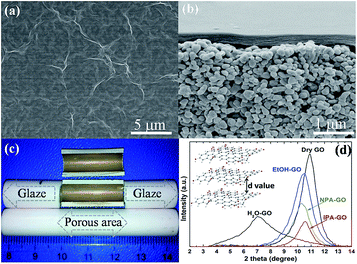 | ||
| Fig. 2 (a) SEM top views; (b) SEM cross-section view; (c) optical image of GO/Al2O3 membrane; (d) XRD patterns of GO membrane in solvents. | ||
The pervaporation separation of GO membranes for water–organic mixtures was carried out in a flow system (Fig. S5†). The membrane performance was evaluated by the flux (J) and separation factor (α) determined as follows:
 | (1) |
 | (2) |
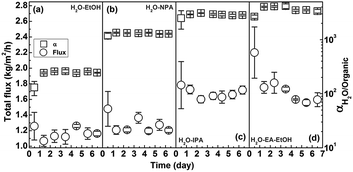 | ||
| Fig. 3 Separation behaviors of GO/ceramic membranes for the water–organic (1/9) mixtures at 70 °C. (a) H2O–EtOH, (b) H2O–NPA, (c) H2O–IPA and (d) H2O–EA–EtOH (1/8/1). | ||
Obviously, the separation factors of the GO membrane for different mixtures increased with the size of organic molecules, which is well consistent with the observation of Joshi et al.9 The thickness of single layer GO is ∼3.5 Å, so the distance between hydrated GO layers is ∼8.9 Å (= 12.4–3.5 Å, Fig. 2d), which is close to the hydro-dynamic diameter of NPA (8.96 Å).9 It means that molecules larger than NPA will be rejected by the GO membrane due to a molecular sieving mechanism. Therefore, the separation factors significantly increased as the EtOH was replaced by NPA, IPA, EA and butanol isomers. On the other hand, the GO membrane also can block the permeation of molecules smaller than the distance between GO inter-lamellas (e.g. high αH2O–EtOH), which might be attributed to the incomparability between hydrophilic GO and hydrophobic organics.
The separation performance of the GO composite membrane was compared with the upper bound plot of polymeric membranes as well as GO based membranes6,7,17–19 (Fig. 4). In the case of H2O–EtOH separation, the GO composite membrane is located on the asymptotic line of the upper boundary of polymer membranes and shows an adequate performance in comparison with others (Fig. 4a).17 For larger molecules e.g. IPA and EA, however, the performance of the GO membrane is better than that of most of polymeric membranes (Fig. 4b and c).17a,18,19 It demonstrates that GO/ceramic membrane has extraordinary separation properties for azeotropes separation. On the other hand, the flux of GO/ceramic membrane for H2O–EtOH separation was similar to that of the ca. 10 μm thick and unsupported GO membrane7 (Fig. 4a). But the H2O–ethanol separation factor is little bit higher than that of it due to the thinner GO selective layer of our membrane. For the IPA–H2O separation, the GO/ceramic membrane shows a higher separation factor but lower permeability than the ca. 1 μm thick GO/modified polyacrylonitrile (mPAN) membrane.6 Suhas et al. reported GO doped sodium alginate membranes for IPA–H2O pervaporation separation, in which a flux of 2.7 kg m−2 h and a selectivity of 4623 were achieved.13 The separation performance of GO/ceramic membrane is also comparable to that kind of GO modified membranes.
The permeation behaviour of the GO membrane was investigated for various mixtures with 10% H2O at different temperature. The permeation flux increased with temperature rise from 30–70 °C (Fig. 5), which can be expressed by an Arrhenius equation:
 | (3) |
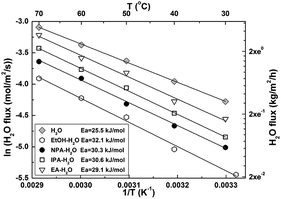 | ||
| Fig. 5 Temperature dependence of GO composite membranes. H2O fluxes of pure water have been divided by 2 for clarity of display. | ||
In summary, extremely flexible GO was successfully combined with rigid porous ceramic tubes to form an ultrathin composite membrane by a preparation method that integrated opposite-charges attraction and pressure driven asymmetric deposition. Charge modification of GO not only improved the stability of the composite membrane but also protected the original properties of GO by introducing a short amine. Extraordinary separation performances of the GO membranes were achieved from the pervaporation of water-contained binary and ternary azeotropes. The high separation factor towards water is mainly attributed to the molecular sieving effect from the narrow opening (distance) between GO layers (especially for molecules larger than NPA). The incompatibility between the hydrophilic GO layers and the hydrophobic organic molecules also contribute to the separation. The stability of GO composite membranes was proved through one week pervaporation testing. The temperature dependence of H2O permeation suggests that organic molecules have weak interaction with GO membranes during the separation.
Acknowledgements
This work was supported by National 863 Project of China (no. 2012AA050104) and Advanced Coal Project of Chinese Academy of Sciences (no. XDA07040401).Notes and references
- (a) Y. R. Lee, S. C. Kiml, H. Lee, H. M. Jeong, A. V. Raghu, K. R. Reddy and B. K. Kim, Macromol. Res., 2011, 19, 67 Search PubMed; (b) S. Han, H. Lee, H. Jeong, B. Kim, A. V. Raghu and K. Reddy, J. Macromol. Sci., Part B: Phys., 2014, 53, 1193 CrossRef CAS.
- (a) H. Li, Z. Song, X. Zhang, Y. Huang, S. Li, Y. Mao, H. Ploehn, Y. Bao and M. Yu, Science, 2013, 342, 95 CrossRef CAS PubMed; (b) H. Kim, H. Yoon, S. Yoon, B. Yoo, B. Ahn, Y. Cho, H. Shin, H. Yang, U. Paik, S. Kwon, J. Choi and H. Park, Science, 2013, 342, 91 CrossRef CAS PubMed.
- R. Nair, H. Wu, P. Jayaram, I. Grigorieva and A. Geim, Science, 2012, 335, 442 CrossRef CAS PubMed.
- W. Choi, J. Choi, J. Bang and J. Lee, ACS Appl. Mater. Interfaces, 2013, 5, 12510 CAS.
- B. Mi, Science, 2014, 343, 740 CrossRef CAS PubMed.
- W. Hung, Q. An, M. De Guzman, H. Lin, S. Huang, W. Liu, C. Hu, K. Lee and J. Lai, Carbon, 2014, 68, 670 CrossRef CAS PubMed.
- Y. Tang, D. Paul and T. Chung, J. Membr. Sci., 2014, 458, 1998 CrossRef PubMed.
- P. Sun, F. Zheng, M. Zhu, Z. Song, K. Wang, M. Zhong, D. Wu, R. Little, Z. Xu and H. Zhu, ACS Nano, 2014, 8, 850 CrossRef CAS PubMed.
- R. Joshi, P. Carbone, F. Wang, V. Kravets, Y. Su, I. Grigorieva, H. Wu, A. Geim and R. Nair, Science, 2014, 343, 752 CrossRef CAS PubMed.
- H. Huang, Y. Mao, Y. Ying, Y. Liu, L. Sun and X. Peng, Chem. Commun., 2013, 49, 5963 RSC.
- M. Hu and B. Mi, Environ. Sci. Technol., 2013, 47, 3715 CrossRef CAS PubMed.
- W. Hung, C. Tsou, M. Guzman, Q. An, Y. Liu, Y. Zhang, C. Hu, K. Lee and J. Lai, Chem. Mater., 2014, 26, 2983 CrossRef CAS.
- D. P. Suhas, A. V. Raghu, H. M. Jeong and T. M. Aminabhavi, RSC Adv., 2013, 3, 17120 RSC.
- R. Liu, G. Arabale, J. Kim, K. Sun, Y. Lee, C. Ryu and C. Lee, Carbon, 2014, 77, 933–938 CrossRef CAS PubMed.
- J. Suk, R. Piner, J. An and R. Ruoff, ACS Nano, 2010, 4, 6557 CrossRef CAS PubMed.
- W. Hummers and R. Offeman, J. Am. Chem. Soc., 1958, 80, 1339 CrossRef CAS.
- (a) P. Chapmana, T. Oliveirab, A. Livingstona and K. Li, J. Membr. Sci., 2008, 318, 5 CrossRef PubMed; (b) K. Sunitha, Carbohydr. Polym., 2012, 87, 1569 CrossRef CAS PubMed; (c) C. Lai and Y. Fu, Sep. Purif. Technol., 2012, 100, 15 CrossRef CAS PubMed; (d) K. Pakkethati and A. Boonmalert, Desalination, 2011, 267, 73 CrossRef CAS PubMed.
- (a) Y. Wang, L. Jiang, T. Matsuura, T. Chung and S. Goh, J. Membr. Sci., 2008, 318, 217 CrossRef CAS PubMed; (b) Y. Wang, S. Goh, T. Chung and P. Na, J. Membr. Sci., 2009, 326, 222 CrossRef CAS PubMed; (c) J. Zuo, Y. Wang, S. Sun and T. Chung, J. Membr. Sci., 2012, 406, 123 CrossRef PubMed.
- (a) M. Shahrestani and A. Moheb, Vacuum, 2013, 92, 70 CrossRef PubMed; (b) X. Zhang and Q. Liu, J. Membr. Sci., 2009, 327, 274 CrossRef CAS PubMed; (c) H. Yuan, Desalination, 2011, 280, 252 CrossRef CAS PubMed; (d) Y. Zhu and S. Xia, J. Membr. Sci., 2010, 349, 341 CrossRef CAS PubMed; (e) H. Yuan, Z. Xu, J. Shi and X. Ma, J. Appl. Polym. Sci., 2008, 109, 4025 CrossRef CAS; (f) D. Devi, K. Raju and T. Aminabhavi, J. Appl. Polym. Sci., 2007, 103, 3405 CrossRef CAS; (g) S. Xia and X. Dong, Sep. Purif. Technol., 2011, 77, 53 CrossRef CAS PubMed.
Footnote |
| † Electronic supplementary information (ESI) available: Experimental details and AFM, FTIR and XPS results. See DOI: 10.1039/c4ra09062d |
| This journal is © The Royal Society of Chemistry 2014 |

